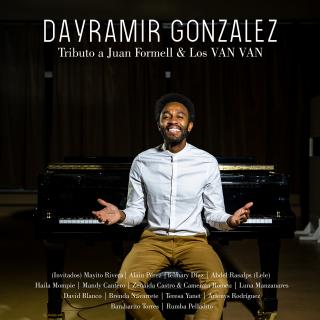
Dayramir González tributo a Juan Formell y los Van Van
The phonogram becomes a mass of creative experiences supported by a group of artists of excellence from contemporary Cuba. In this journey, the charismatic percussionist Brenda Navarrete, the consecrated lutenist Barbarito Torres, the multifaceted rocker David Blanco, the rapper Telmary Díaz, as well as the popular singers Alain Pérez, Mandy Cantero and Mayito Rivera stand out, together with the unique voices of Haila María Mompié. , Luna Manzanares, Teresa Yanet and Arlenys Rodríguez. The folk group of Ramón Justo Pelladito and the Camerata Romeu directed by Zenaida Castro, both exceptional, come together to offer a remarkable spectrum of diverse interpretive styles that enrich and fortify the proposal. The selection criteria took into account 10 works, of which 9 belong to the authorship of the creator of Los Van Van. It is preceded by “Orun a Formell”, a spiritual song with an introductory function and a kind of farewell to the teacher with a marked Afro-Cuban religious character. In this way, Dayramir proposes a journey through 50 years of Formelian creation, and takes up pieces that marked milestones in the history of Los Van Van. This is how we go from the very popular “Marilú” (from 1969) and “El guararey de Pastora” (from 1974), or other lesser-known ones such as “Your decision, what is it” (from 1976), to the more contemporary “Si no te you want” (from 2009) and “Everything is over” (from 2014), going through the eighties “Go, come and move” (from 1984) and “This love that dies” (from 1988), including “My doubts ” and “Leave the nonsense” (both from 1990). Revisiting a work of high impact and popular roots is, without a doubt, an act of extreme daring. Dayramir, who has established himself as one of the most prominent exponents of relocated and manufactured jazz on (or outside) the Island, successfully overcomes the pitfalls that this practice entails, and gives us a new look, in which the original referent is apprehended, revitalized and returned in an interesting dialogue that goes from the traditional to the contemporary, from the classical to the popular, and from the jazzy to the danceable. The merit is double, because in addition to the challenge involved in undertaking a pre-existing and well-known work, his commitment becomes a generational bridge that brings to the present some anthological pieces from the national musical catalog, not only vanvanero.
- Performer(s): Dayramir González. , Invitados Varios.
- Genre(s): Fusión
- Record House: Producciones Abdala
